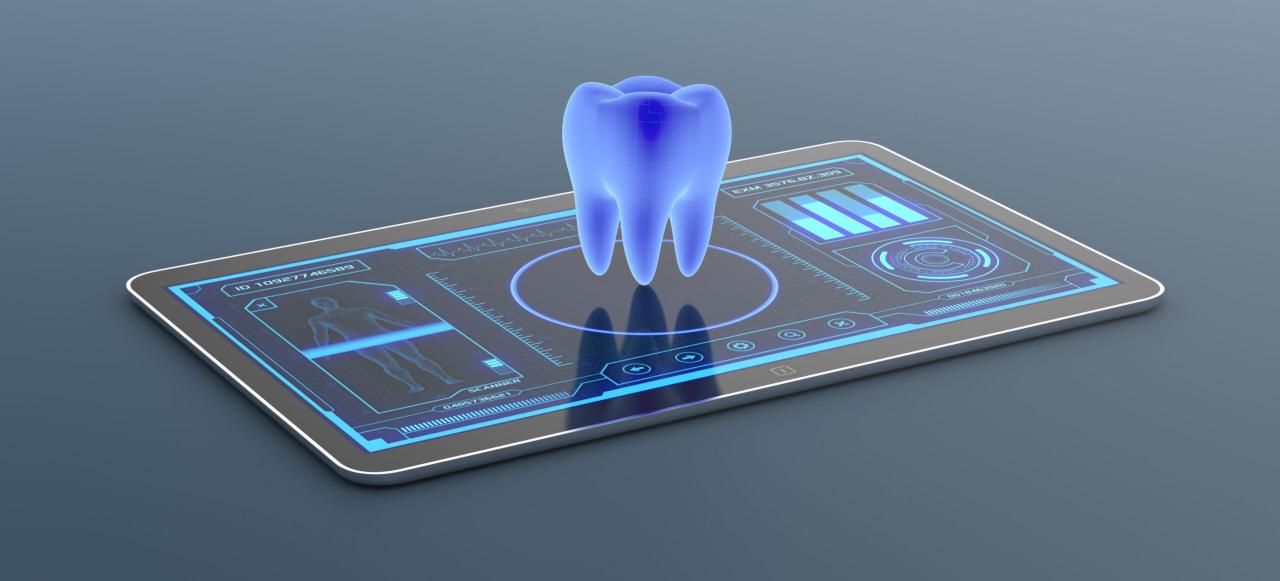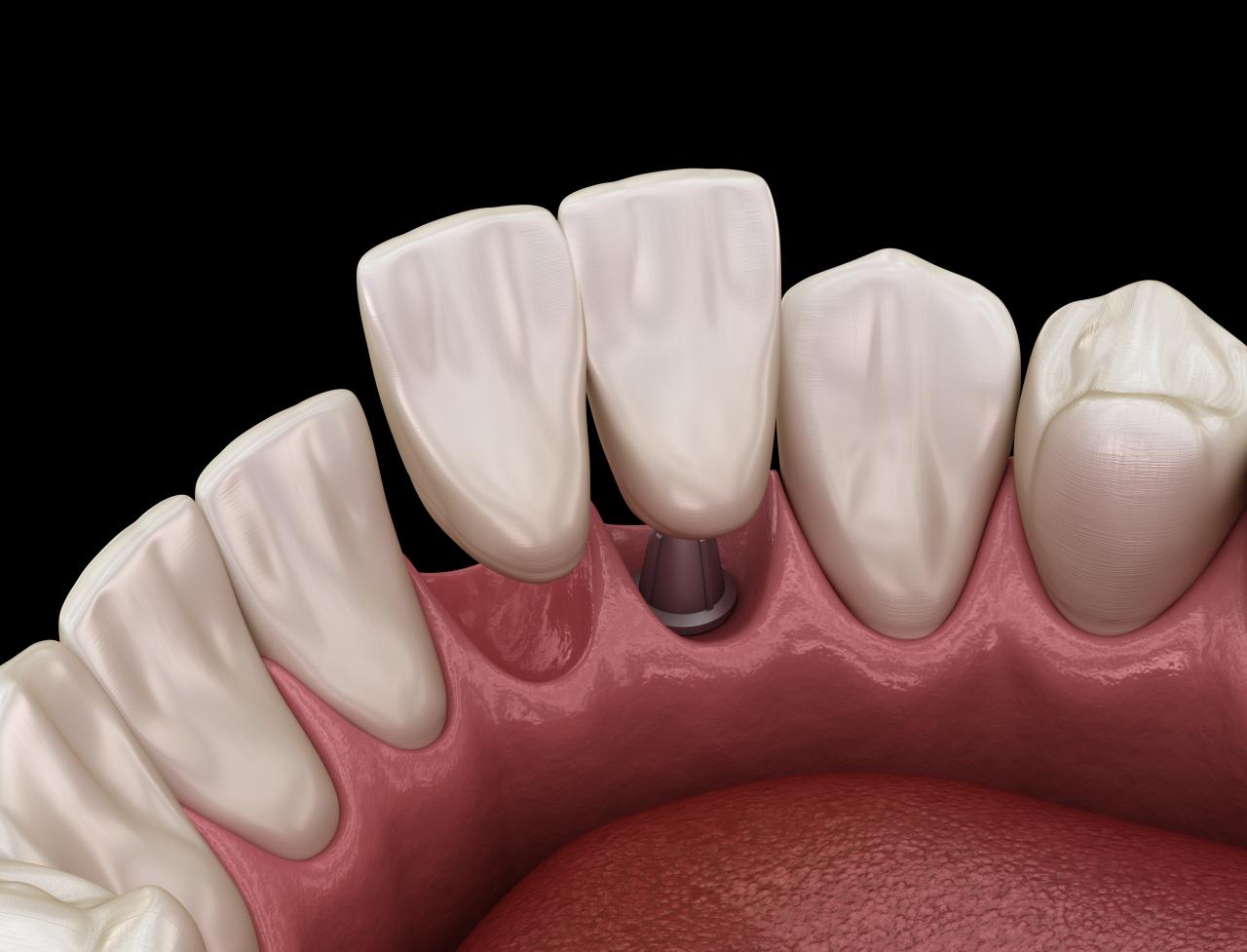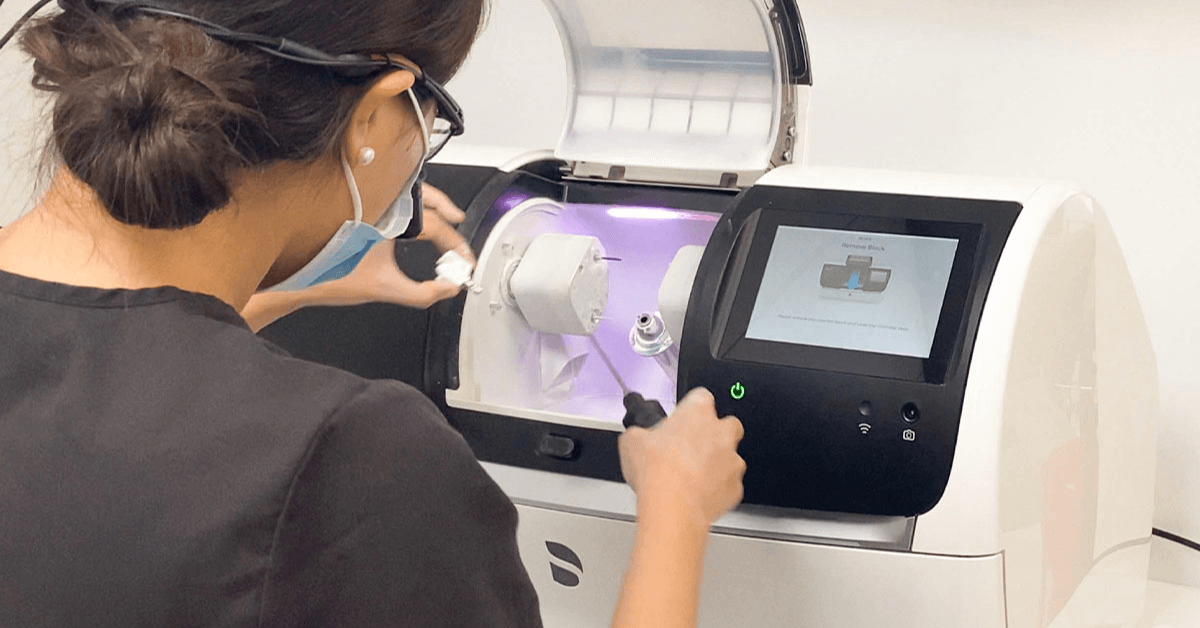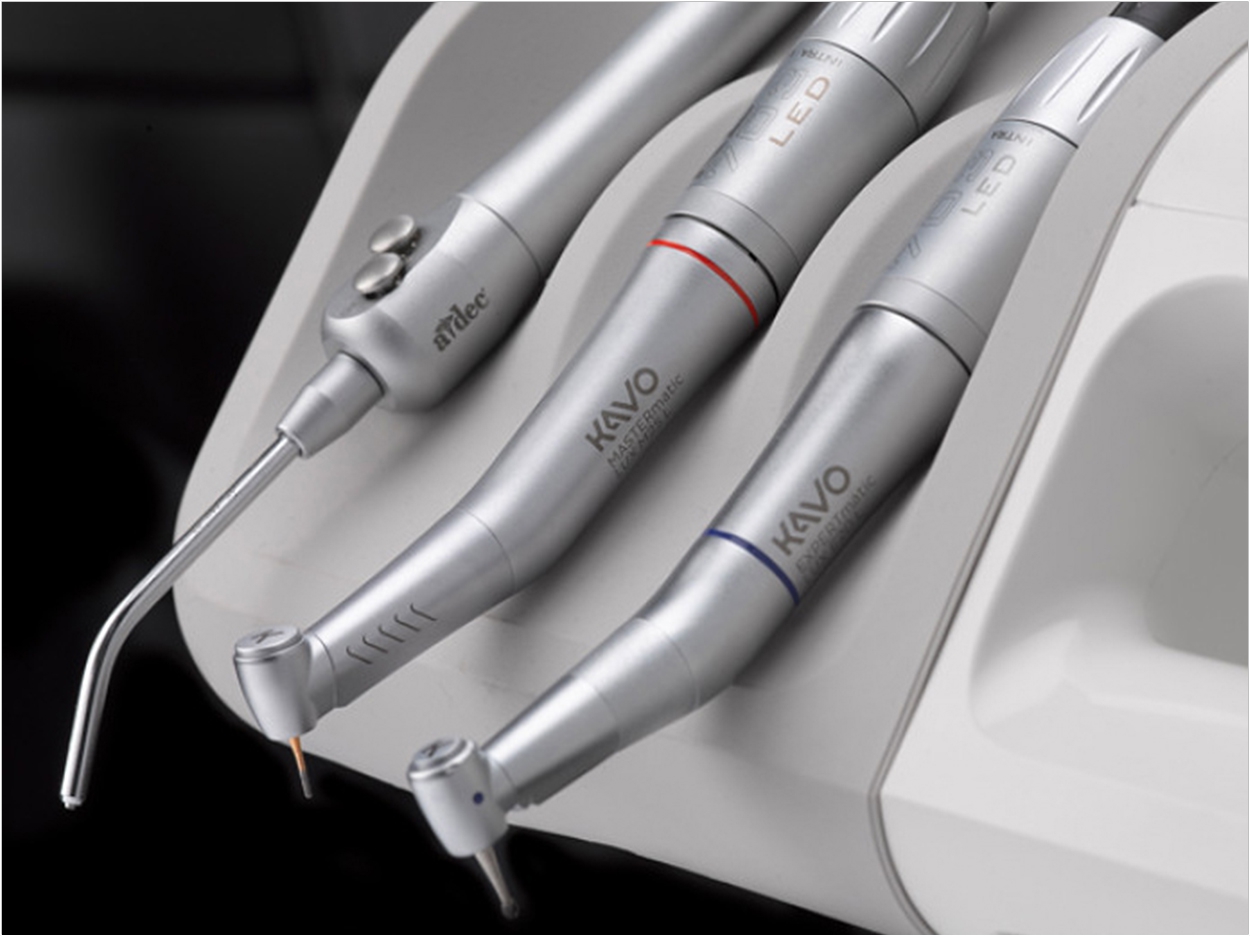Newest Dental Technology: Transforming Smiles
Newest dental technology is revolutionizing the way we care for our smiles. From digital imaging to artificial intelligence, advancements in dentistry are offering patients more comfortable, efficient, and personalized treatments […]

Newest dental technology is revolutionizing the way we care for our smiles. From digital imaging to artificial intelligence, advancements in dentistry are offering patients more comfortable, efficient, and personalized treatments than ever before.
This innovative technology is not only improving the aesthetics of our smiles but also enhancing the overall health and well-being of our mouths. By harnessing the power of digital tools, lasers, 3D printing, and more, dentists are able to diagnose problems more accurately, plan treatments with greater precision, and deliver more effective results.
Digital Dentistry
Digital dentistry has revolutionized the field, bringing about a significant shift from traditional techniques to advanced, technology-driven methods. This transformation has resulted in improved accuracy, efficiency, and patient comfort.
Impact of Digital Imaging and Scanning
Digital imaging and scanning have played a pivotal role in enhancing dental procedures. These technologies allow for the creation of highly detailed, three-dimensional images of the patient’s teeth and jaw, providing dentists with a comprehensive understanding of the oral anatomy.
- Intraoral scanners: These devices capture precise digital impressions of the teeth, eliminating the need for traditional, messy, and uncomfortable impression materials. This process is faster, more accurate, and provides a more comfortable experience for patients.
- Cone-beam computed tomography (CBCT): This advanced imaging technique generates detailed three-dimensional images of the jawbone and surrounding structures. CBCT scans are crucial for complex procedures such as implant placement, root canal therapy, and orthognathic surgery, enabling dentists to plan treatments with greater precision.
Role of CAD/CAM Technology in Creating Dental Restorations
Computer-aided design/computer-aided manufacturing (CAD/CAM) technology has revolutionized the creation of dental restorations, such as crowns, bridges, and inlays.
- Digital design: Once a digital impression is obtained, the dentist uses specialized software to design the restoration, ensuring a precise fit and optimal aesthetics.
- Automated milling: The designed restoration is then sent to a milling machine, which automatically carves the restoration from a block of ceramic or other dental material. This process is highly accurate and eliminates the need for manual fabrication, reducing the risk of errors.
- Same-day dentistry: With CAD/CAM technology, many restorations can be created and placed in a single appointment, minimizing the need for multiple visits and temporary restorations. This offers significant convenience for patients.
Examples of Software Applications for Dental Planning and Treatment
A variety of software applications are used in digital dentistry for planning and executing treatments. These applications facilitate communication, collaboration, and efficiency in the dental practice.
- Treatment planning software: These applications allow dentists to visualize the patient’s anatomy in three dimensions, plan treatment steps, and simulate the final outcome. This provides a clear understanding of the treatment plan and potential complications, enhancing patient communication and informed consent.
- Digital imaging software: These programs are used to view, analyze, and manipulate digital images obtained from intraoral scanners and CBCT scans. They offer tools for image enhancement, measurement, and 3D reconstruction, facilitating diagnosis and treatment planning.
- CAD/CAM software: This software is used to design and manufacture dental restorations. It allows dentists to create custom restorations that perfectly fit the patient’s mouth, ensuring optimal function and aesthetics.
Comparison of Traditional Dental Techniques with Digital Methods
| Feature | Traditional Methods | Digital Methods |
|---|---|---|
| Impression taking | Traditional alginate or polysiloxane impression materials | Intraoral scanners |
| Accuracy | Prone to errors due to material distortion or inaccurate placement | Highly accurate, with minimal distortion |
| Comfort | Can be uncomfortable and messy for patients | More comfortable and less messy |
| Time | Multiple appointments may be required for impression taking and restoration fabrication | Same-day restorations are possible with CAD/CAM technology |
| Cost | Generally less expensive | May be more expensive due to technology costs |
Laser Dentistry

Laser dentistry has revolutionized the way dental procedures are performed, offering numerous advantages over traditional methods. Lasers utilize a highly focused beam of light to precisely target and treat dental issues, resulting in less pain, faster healing, and improved outcomes.
Types of Lasers Used in Dentistry
Different types of lasers are used in dentistry, each with specific applications and benefits.
- Erbium:Yttrium-Aluminum-Garnet (Er:YAG) Laser: This laser is commonly used for hard tissue procedures, such as tooth preparation for fillings, crown placement, and removal of tooth decay. Its ability to precisely remove enamel and dentin with minimal heat generation makes it a preferred choice for these procedures.
- Diode Laser: Diode lasers are versatile and can be used for soft tissue procedures, such as gum surgery, frenectomy (removal of a frenulum), and treatment of periodontal disease. They are also effective in whitening teeth by breaking down stains.
- CO2 Laser: This laser is primarily used for soft tissue procedures, including gum surgery, frenectomy, and removal of soft tissue growths. Its precision and ability to seal blood vessels during surgery reduce bleeding and promote faster healing.
Applications of Lasers in Dental Procedures
Lasers are used in a wide range of dental procedures, offering numerous advantages over traditional methods.
| Type of Laser | Applications |
|---|---|
| Er:YAG Laser | Tooth preparation for fillings, crown placement, removal of tooth decay, and dental implant placement. |
| Diode Laser | Gum surgery, frenectomy, treatment of periodontal disease, and teeth whitening. |
| CO2 Laser | Gum surgery, frenectomy, removal of soft tissue growths, and treatment of oral lesions. |
Advantages of Laser Dentistry
Laser dentistry offers several advantages over traditional methods, including:
- Reduced Pain and Discomfort: The precision of lasers minimizes tissue damage and reduces pain during procedures.
- Faster Healing: Lasers seal blood vessels during surgery, reducing bleeding and promoting faster healing.
- Minimally Invasive: Lasers allow for precise targeting, reducing the need for extensive incisions and preserving healthy tissue.
- Improved Accuracy: Lasers provide a high level of accuracy, ensuring precise and predictable outcomes.
3D Printing in Dentistry: Newest Dental Technology
3D printing, also known as additive manufacturing, has emerged as a transformative technology in dentistry, revolutionizing the way dental professionals design, fabricate, and deliver treatments. It involves building three-dimensional objects layer by layer from a digital design using a variety of materials.
Creating Dental Models, Implants, and Prosthetics
3D printing enables the creation of highly accurate and detailed dental models, implants, and prosthetics. The process begins with a digital scan of the patient’s teeth and jaw using an intraoral scanner. This scan generates a 3D digital model that is then used to create a custom-made dental device. The 3D printer uses a variety of materials, such as resins, polymers, ceramics, and metals, to build the object layer by layer. This allows for the creation of complex and intricate designs that would be difficult or impossible to achieve with traditional methods.
Revolutionizing Dental Education and Research
3D printing is revolutionizing dental education and research by providing realistic and interactive models for students and researchers. Students can use 3D printed models to practice their skills and understand complex anatomical structures. Researchers can use 3D printing to create prototypes for new dental devices and materials, enabling them to test and refine their designs before moving to clinical trials. 3D printing also allows for the creation of personalized anatomical models, which can be used to simulate specific patient cases and improve the accuracy of diagnosis and treatment planning.
Advantages and Limitations of 3D Printing in Dentistry
3D printing offers several advantages in dentistry, including:
- Increased Accuracy and Precision: 3D printing allows for the creation of highly accurate and detailed dental models, implants, and prosthetics, leading to improved fit and function.
- Reduced Treatment Time: 3D printing can significantly reduce the time required to fabricate dental devices, enabling faster treatment and improved patient satisfaction.
- Enhanced Patient Comfort: 3D printed models can be used to create custom-made mouthguards and aligners, providing a more comfortable fit and reducing the risk of irritation or discomfort.
- Improved Aesthetics: 3D printing allows for the creation of highly realistic and aesthetically pleasing dental devices, improving patient confidence and self-esteem.
- Cost-Effectiveness: In some cases, 3D printing can be more cost-effective than traditional methods, particularly for complex dental procedures.
However, 3D printing also has some limitations:
- Material Limitations: The range of materials that can be used in 3D printing is still limited compared to traditional dental materials, which may restrict its use in certain applications.
- Cost of Equipment: 3D printers can be expensive, making them inaccessible to some dental practices.
- Skill Requirements: Using 3D printing effectively requires specialized training and skills, which may require additional investment in education and training.
Materials Commonly Used in 3D Printing for Dental Applications
A variety of materials are commonly used in 3D printing for dental applications, each with its own unique properties and applications:
- Resins: Photopolymerizable resins are commonly used for creating dental models, aligners, and temporary crowns. They offer good accuracy and detail, but may not be as durable as other materials.
- Polymers: Thermoplastic polymers, such as polyamide (PA) and polyethylene (PE), are used for creating surgical guides, implant models, and retainers. They are strong, durable, and biocompatible.
- Ceramics: Ceramic materials, such as zirconia and alumina, are used for creating dental crowns, bridges, and implants. They are highly biocompatible, strong, and aesthetically pleasing.
- Metals: Titanium and cobalt-chromium alloys are used for creating dental implants and frameworks. They are strong, biocompatible, and corrosion-resistant.
Artificial Intelligence in Dentistry
Artificial intelligence (AI) is rapidly transforming various industries, and dentistry is no exception. AI is being integrated into dental practices, revolutionizing how dentists diagnose, plan treatments, and provide care. This technology is poised to enhance patient outcomes, improve efficiency, and personalize dental experiences.
AI in Dental Diagnosis and Treatment Planning
AI algorithms are being trained on massive datasets of dental images, patient records, and medical literature to assist dentists in diagnosing dental conditions with greater accuracy. AI-powered software can analyze X-rays, photographs, and other imaging data to identify subtle signs of dental problems that might be missed by the human eye. This can help dentists detect early signs of cavities, gum disease, and other dental issues, leading to more timely interventions and better treatment outcomes.
Furthermore, AI can aid in treatment planning by analyzing patient data and suggesting personalized treatment options. By considering factors such as patient age, medical history, dental health, and lifestyle, AI algorithms can recommend the most appropriate treatment approaches, including the use of specific materials, techniques, and procedures. This can help dentists create more comprehensive and effective treatment plans tailored to each patient’s individual needs.
AI’s Impact on Accuracy and Efficiency of Dental Procedures
AI is not only changing how dentists diagnose and plan treatments but also how they perform procedures. AI-powered robotic systems can assist dentists in performing complex procedures with greater precision and accuracy. For example, AI-assisted surgery systems can help dentists place implants with greater accuracy, minimizing the risk of complications and improving the long-term success of the procedure.
Moreover, AI can improve the efficiency of dental procedures by automating repetitive tasks. AI-powered software can analyze patient data and generate treatment plans, freeing up dentists’ time to focus on patient interaction and more complex procedures. This can lead to shorter treatment times, reduced waiting times for patients, and increased overall efficiency in dental practices.
Ethical Considerations of AI in Dentistry
While AI offers significant potential benefits for dentistry, it also raises ethical concerns. One key concern is the potential for bias in AI algorithms. If the data used to train AI algorithms is biased, the algorithms may perpetuate these biases, leading to unfair or discriminatory treatment of patients. It is crucial to ensure that the data used to train AI algorithms is representative of the population it will serve and to develop safeguards against bias.
Another ethical consideration is the potential for AI to dehumanize the patient experience. If dentists rely too heavily on AI algorithms, they may lose sight of the importance of human interaction and empathy. It is important to strike a balance between using AI to enhance care and maintaining the human touch that is essential for a positive patient experience.
Benefits and Challenges of AI in Dentistry
| Benefits | Challenges |
|—|—|
| Improved accuracy in diagnosis | Potential for bias in AI algorithms |
| More efficient treatment planning | Need for high-quality data to train AI algorithms |
| Increased precision in dental procedures | Ethical concerns regarding patient privacy and autonomy |
| Reduced treatment time | Cost of implementing AI technology |
| Enhanced patient experience | Lack of regulation and standardization in the use of AI in dentistry |
Robotics in Dentistry
Robotics is revolutionizing the dental field, offering new possibilities for improved precision, efficiency, and patient comfort. Robotic systems are becoming increasingly sophisticated, capable of performing complex procedures with greater accuracy and minimal human intervention.
Current and Potential Applications of Robotics in Dental Surgery
Robotic systems are currently employed in various dental procedures, enhancing precision and minimizing human error. These applications include:
- Implantology: Robotic arms assist in implant placement, ensuring accurate positioning and reducing the risk of damage to surrounding tissues.
- Endodontics: Robots can navigate root canals with precision, facilitating root canal treatment with increased accuracy and efficiency.
- Oral Surgery: Robotic systems assist in complex oral surgeries, such as tumor removal and bone grafting, by providing a steady hand and enhanced visualization.
- Prosthodontics: Robots are used in the fabrication of dental prosthetics, such as crowns and bridges, ensuring precise fit and improved aesthetics.
- Preventive Dentistry: Robotic systems can be utilized for teeth cleaning and scaling, offering a more thorough and gentle experience for patients.
The potential applications of robotics in dentistry extend beyond current practices, promising a future where robotic assistance becomes an integral part of dental care.
Robotic Assistance Improves Precision and Minimizes Human Error
Robotic systems excel in tasks that require precision and stability, surpassing human capabilities in many areas. This advantage is particularly valuable in dentistry, where even minute errors can impact treatment outcomes.
- Enhanced Accuracy: Robotic arms are programmed with precise movements, minimizing human tremors and inaccuracies that can occur during delicate procedures.
- Minimized Invasiveness: Robots can perform procedures with greater control, reducing the need for extensive incisions and minimizing tissue damage.
- Improved Consistency: Robotic systems deliver consistent results, ensuring uniformity and predictability in treatment outcomes.
- Reduced Procedural Time: Robots can perform tasks more efficiently, potentially shortening procedure times and improving patient comfort.
Examples of Robotic Systems Currently Used in Dental Procedures
Several robotic systems are currently being utilized in dental procedures, demonstrating the growing role of robotics in the field.
- The Yomi® System: Developed by Neocis, this robotic arm assists in implant placement, guiding the surgeon’s hand with precision and providing real-time feedback. This system ensures accurate implant positioning, minimizing the risk of damage to surrounding tissues.
- The NAVident® System: This robotic system, manufactured by Glidewell Dental, offers advanced navigation capabilities for implant surgery. It utilizes 3D imaging to create a virtual model of the patient’s jaw, allowing the surgeon to plan and execute implant placement with precision.
- The ROSA® System: This robotic system, developed by Medtech, is used in various surgical procedures, including oral surgery. It provides a stable platform for the surgeon, enhancing visualization and precision during complex procedures.
Potential Future Applications of Robotics in Dentistry
Robotics in dentistry is poised to play an even more significant role in the future, with advancements in technology opening up new possibilities for treatment and care.
- Fully Automated Procedures: The development of advanced robotic systems could lead to fully automated dental procedures, eliminating the need for human intervention in certain tasks.
- Personalized Treatment Plans: Robots equipped with AI capabilities can analyze patient data and create personalized treatment plans, optimizing outcomes for individual needs.
- Remote Dentistry: Robotics could enable remote dental care, allowing patients in remote areas to access specialized treatment through telemedicine.
- Enhanced Patient Experience: Robotic systems can enhance the patient experience by providing greater comfort, precision, and efficiency during procedures.
Biomaterials and Nanomaterials in Dentistry
The field of dentistry has witnessed a remarkable evolution in recent years, driven by advancements in biomaterials and nanomaterials. These materials are revolutionizing dental procedures, leading to more durable, biocompatible, and aesthetically pleasing restorations.
Advanced Biomaterials for Dental Implants and Restorations
Biomaterials play a crucial role in dental implants and restorations. They must possess specific properties to integrate seamlessly with the surrounding tissues, providing long-lasting functionality. Titanium, a widely used biomaterial, exhibits excellent biocompatibility and osseointegration, allowing it to bond with bone tissue. Zirconia, another biomaterial, offers superior strength and aesthetics, making it suitable for crowns, bridges, and implants. Bioactive glasses, known for their ability to stimulate bone regeneration, are increasingly used in dental implants to promote faster healing and integration.
The Role of Nanotechnology in Enhancing the Properties of Dental Materials
Nanotechnology has emerged as a powerful tool for enhancing the properties of dental materials. By manipulating materials at the nanoscale, researchers can improve their strength, biocompatibility, and aesthetic appeal. For instance, the incorporation of nanoparticles into dental composites can enhance their mechanical properties, making them more resistant to wear and tear. Nanomaterials can also improve the bonding of dental materials to tooth surfaces, resulting in stronger and longer-lasting restorations.
Benefits and Challenges of Using Biomaterials and Nanomaterials in Dentistry
The use of biomaterials and nanomaterials in dentistry offers numerous benefits. These materials are biocompatible, promoting tissue integration and minimizing the risk of rejection. They exhibit enhanced strength and durability, leading to longer-lasting restorations. Additionally, biomaterials and nanomaterials often offer improved aesthetics, allowing for more natural-looking restorations.
However, there are also challenges associated with these materials. Some biomaterials may be susceptible to corrosion or degradation over time, requiring maintenance or replacement. The long-term effects of nanomaterials on human health are still under investigation, and more research is needed to ensure their safety.
Comparison of Traditional Dental Materials with Advanced Biomaterials
| Property | Traditional Dental Materials | Advanced Biomaterials |
|---|---|---|
| Strength | Lower | Higher |
| Biocompatibility | Variable | Excellent |
| Aesthetics | Limited | Improved |
| Durability | Lower | Higher |
| Cost | Lower | Higher |
Personalized Dentistry
Personalized dentistry is a revolutionary approach to dental care that tailors treatments and preventive measures to each patient’s unique needs and characteristics. This approach recognizes that every individual has a distinct genetic makeup, oral microbiome, lifestyle, and health history, which influence their susceptibility to dental diseases and their response to treatments.
Genetic Testing in Personalized Dentistry
Genetic testing can provide valuable insights into an individual’s predisposition to dental diseases. By analyzing specific genes associated with dental health, dentists can identify patients at higher risk for conditions like caries, periodontal disease, and oral cancer. This information allows for proactive interventions and personalized preventive strategies to minimize the risk of developing these diseases.
Personalized Dental Treatments and Technologies
Personalized dentistry employs a range of advanced technologies to deliver tailored dental care. For instance, 3D imaging technologies, such as cone-beam computed tomography (CBCT), create highly detailed images of the teeth, gums, and surrounding bone structures, enabling dentists to develop precise treatment plans.
Factors Influencing Personalized Dental Care
Several factors contribute to the personalized nature of dental care. These include:
- Genetic Predisposition: Genetic testing can identify individuals with a higher risk for certain dental conditions, enabling personalized preventive strategies and early interventions.
- Oral Microbiome: The composition of bacteria in the mouth varies between individuals, influencing their susceptibility to dental diseases. Personalized interventions may target specific bacterial species to prevent disease.
- Lifestyle and Habits: Factors like diet, smoking, and oral hygiene practices significantly impact dental health. Personalized recommendations can help patients modify their habits to improve oral health.
- Medical History: Certain medical conditions can affect oral health. Personalized dental care considers these factors and adjusts treatments accordingly.
- Dental History: Past dental treatments, experiences, and preferences influence the personalized approach to care.
Tele dentistry and Remote Monitoring
Tele dentistry, also known as telehealth dentistry, involves the use of technology to provide dental care remotely. This innovative approach leverages digital tools to connect patients with dental professionals, enabling consultations, diagnoses, and even treatment planning from a distance.
Applications of Tele dentistry, Newest dental technology
Tele dentistry offers a wide range of applications in dental care, expanding access to dental services and improving patient care.
- Remote Consultations: Patients can connect with dentists via video conferencing for initial consultations, follow-up appointments, or second opinions. This eliminates the need for physical visits, especially for patients in remote areas or with limited mobility.
- Diagnosis and Treatment Planning: Dentists can use tele dentistry to diagnose dental issues based on patient-submitted photos, videos, or digital scans. This allows for preliminary diagnosis and treatment planning before a physical examination.
- Patient Education and Instructions: Tele dentistry facilitates remote instruction on oral hygiene practices, post-treatment care, and other dental-related information. This enhances patient understanding and compliance.
- Emergency Care: In emergency situations, patients can connect with dentists via tele dentistry for immediate advice and guidance, potentially preventing complications or unnecessary visits to emergency rooms.
Remote Monitoring Devices
Remote monitoring devices play a crucial role in teledentistry, enabling continuous tracking of patients’ oral health conditions.
- Smart Toothbrushes: These devices track brushing patterns, duration, and pressure, providing feedback to patients and dentists on oral hygiene practices.
- Intraoral Cameras: Patients can capture images of their mouths using intraoral cameras, allowing dentists to remotely assess oral health conditions and provide personalized advice.
- Wearable Sensors: Sensors embedded in mouthguards or dentures can monitor teeth grinding, jaw clenching, and other oral habits, providing valuable data for diagnosis and treatment planning.
- Remote Monitoring Platforms: These platforms collect data from various devices, enabling dentists to track patients’ progress, identify potential issues, and intervene early.
Benefits of Tele dentistry and Remote Monitoring
Tele dentistry and remote monitoring offer numerous benefits to both patients and dentists:
- Improved Access to Care: Tele dentistry expands access to dental services for individuals in remote areas, underserved communities, and those with limited mobility.
- Increased Convenience: Tele dentistry eliminates the need for physical visits, saving patients time and travel expenses.
- Enhanced Patient Engagement: Remote monitoring devices empower patients to take an active role in managing their oral health.
- Early Detection and Prevention: Continuous monitoring can identify potential issues early, enabling timely intervention and preventive measures.
- Cost-Effectiveness: Tele dentistry can reduce the overall cost of dental care by minimizing the need for physical visits and expensive procedures.
Challenges of Tele dentistry and Remote Monitoring
Despite its numerous advantages, teledentistry and remote monitoring also present some challenges:
- Technological Barriers: Access to reliable internet connectivity and appropriate devices is essential for effective tele dentistry.
- Privacy and Security Concerns: Ensuring the confidentiality and security of patient data is crucial in tele dentistry.
- Regulatory Issues: Legal and regulatory frameworks for tele dentistry are still evolving, requiring clarity and standardization.
- Limited Diagnostic Capabilities: While tele dentistry can facilitate diagnosis, it may not replace the need for physical examinations in all cases.
- Lack of Physical Interaction: Tele dentistry can limit the personal interaction between patients and dentists, which can be important for building trust and rapport.
Comparison of Traditional Dental Consultations with Tele dentistry
| Feature | Traditional Dental Consultations | Tele dentistry |
|---|---|---|
| Location | Dental office | Remote (patient’s home, office, etc.) |
| Mode of Communication | In-person interaction | Video conferencing, phone calls, online chat |
| Diagnostic Tools | Physical examination, X-rays, dental instruments | Photos, videos, digital scans, remote monitoring devices |
| Treatment Planning | In-person consultation | Remote consultation, based on available data |
| Treatment Delivery | In-person procedures | Limited to non-invasive procedures or guidance for self-care |
| Cost | Typically higher, including travel and waiting time | Potentially lower, depending on services and insurance coverage |
| Accessibility | Limited by location and availability | Increased accessibility for remote or mobile patients |
Dental Implants and Bone Regeneration
Dental implants have revolutionized the field of dentistry, offering a permanent and natural-looking solution for missing teeth. These implants are artificial tooth roots that are surgically placed into the jawbone, providing a stable foundation for crowns, bridges, or dentures. Bone regeneration plays a crucial role in the success of dental implants, ensuring adequate bone volume and density for optimal implant integration.
Advancements in Dental Implant Technology
Significant advancements have been made in dental implant technology, resulting in improved implant materials, designs, and surgical techniques. These advancements have led to shorter healing times, increased implant success rates, and enhanced patient comfort.
- Surface Modifications: Implant surfaces have been modified to promote faster bone integration and reduce the risk of implant failure. These modifications include surface treatments like sandblasting, acid etching, and the use of bioactive coatings.
- Implant Designs: Advances in implant designs have focused on creating implants with improved biomechanical properties and increased stability. This includes implants with different diameters, lengths, and shapes to suit specific anatomical requirements.
- Minimally Invasive Techniques: The development of minimally invasive surgical techniques has reduced the need for extensive bone grafting procedures, leading to faster recovery times and less post-operative discomfort. These techniques often utilize guided surgery with 3D imaging, which allows for precise implant placement.
Bone Regeneration in Implant Placement
Bone regeneration is the process of repairing or rebuilding bone tissue that has been lost or damaged. This process is essential for dental implants, as it ensures that the implant has sufficient bone support for stability and longevity.
- Bone Grafting: Bone grafting is a surgical procedure used to augment bone volume in areas where it is insufficient for implant placement. Bone grafts can be harvested from the patient’s own body (autografts) or obtained from donors (allografts) or synthetic materials (xenografts).
- Growth Factors and Biomaterials: Growth factors and biomaterials are used to stimulate bone regeneration and promote healing. These substances are often incorporated into bone grafts or used in conjunction with other regenerative techniques.
- Stem Cell Therapy: Stem cell therapy is a promising new approach to bone regeneration. Stem cells have the potential to differentiate into bone cells, contributing to bone formation and repair.
Benefits and Risks of Dental Implants
Dental implants offer numerous benefits over traditional tooth replacement options, but it’s important to consider the potential risks as well.
Benefits
- Natural Appearance and Function: Dental implants closely resemble natural teeth, restoring both aesthetics and function.
- Durability: Dental implants are designed to last for many years, providing a long-term solution for missing teeth.
- Improved Oral Health: Dental implants help maintain the integrity of the jawbone, preventing bone loss and preserving facial structure.
- Enhanced Speech and Confidence: Implants can improve speech clarity and contribute to a more confident smile.
Risks
- Infection: As with any surgical procedure, there is a risk of infection.
- Implant Failure: Implant failure can occur if the implant does not integrate properly with the bone.
- Nerve Damage: In rare cases, nerve damage can occur during implant placement.
- Sinus Problems: If implants are placed in the upper jaw, there is a risk of complications involving the sinuses.
- Cost: Dental implants are typically more expensive than other tooth replacement options.
Types of Dental Implants
There are various types of dental implants available, each with its own unique characteristics and applications.
- Endosteal Implants: These are the most common type of implant, consisting of a titanium post that is surgically placed into the jawbone.
- Subperiosteal Implants: These implants are placed on top of the jawbone, under the gum tissue. They are typically used when there is insufficient bone volume for endosteal implants.
- Zygomatic Implants: These implants are longer than traditional implants and are used to support dentures in cases of extensive bone loss. They are placed in the cheekbone, providing a stable anchor for the dentures.
- Mini Implants: These are smaller implants that are used to stabilize dentures or support crowns. They are typically used in cases of limited bone volume.
Pain Management and Sedation
Dental procedures can sometimes cause discomfort or pain, and modern dentistry offers various techniques to manage these concerns. Pain management and sedation are crucial aspects of providing a comfortable and positive experience for patients.
Types of Anesthesia
Anesthesia plays a vital role in pain management during dental procedures. The type of anesthesia used depends on the complexity of the procedure and the patient’s needs.
- Local Anesthesia: This is the most common type of anesthesia used in dentistry. It numbs a specific area of the mouth, typically by injecting a solution containing a local anesthetic, such as lidocaine or bupivacaine. The effect is localized and temporary, allowing the patient to remain conscious and responsive throughout the procedure.
- Nitrous Oxide (Laughing Gas): This is a mild sedative that is inhaled through a mask. It helps relax the patient and reduces anxiety, making the procedure more comfortable. Nitrous oxide is often used in combination with local anesthesia, particularly for patients who are nervous or anxious about dental treatment.
- Conscious Sedation: This involves administering medications intravenously (IV) to induce a state of relaxation and drowsiness. The patient remains conscious but is less aware of their surroundings and experiences minimal discomfort. Common medications used for conscious sedation include benzodiazepines and propofol.
- General Anesthesia: This is a deeper level of sedation that renders the patient unconscious. It is typically reserved for complex or lengthy procedures, such as oral surgery. General anesthesia is administered by a qualified anesthesiologist and requires close monitoring throughout the procedure.
Benefits and Risks of Sedation Methods
Each sedation method has its own set of benefits and risks, which should be carefully discussed with the dentist before making a decision.
- Local Anesthesia:
- Benefits: Effective for most procedures, simple and quick administration, minimal side effects.
- Risks: Possible discomfort during injection, temporary numbness, allergic reactions (rare).
- Nitrous Oxide:
- Benefits: Reduces anxiety and discomfort, quick onset and recovery, safe for most patients.
- Risks: Nausea or vomiting (rare), dizziness, temporary confusion, potential for addiction (rare).
- Conscious Sedation:
- Benefits: Deep relaxation, reduced anxiety, minimal discomfort, fast recovery.
- Risks: Potential for allergic reactions, nausea or vomiting, drowsiness, respiratory depression (rare).
- General Anesthesia:
- Benefits: Unconsciousness and pain relief, ideal for complex procedures, safe when administered by a qualified anesthesiologist.
- Risks: Potential complications, such as respiratory depression, allergic reactions, and cardiovascular problems (rare), longer recovery time.
Comparison of Pain Management and Sedation Options
| Method | Description | Benefits | Risks |
|---|---|---|---|
| Local Anesthesia | Numbs a specific area | Effective, simple, minimal side effects | Injection discomfort, temporary numbness, allergic reactions |
| Nitrous Oxide | Inhaled gas for relaxation | Reduces anxiety, quick onset and recovery | Nausea, dizziness, temporary confusion, addiction |
| Conscious Sedation | IV medication for relaxation | Deep relaxation, minimal discomfort, fast recovery | Allergic reactions, nausea, drowsiness, respiratory depression |
| General Anesthesia | Unconsciousness | Pain relief, ideal for complex procedures | Complications, longer recovery time |
Ending Remarks
The future of dentistry is bright, filled with exciting possibilities thanks to the continuous development of cutting-edge technology. As these innovations continue to evolve, we can expect even more advanced treatments, personalized care, and ultimately, healthier and happier smiles for all.
The newest dental technology is impressive, from 3D imaging to laser dentistry. However, it’s not just the tools that are evolving; even the lighting in dental offices is getting a makeover. Companies like Halco are leading the way in dental lighting with innovative solutions that provide better visibility and a more comfortable experience for patients.
Halco lighting technology is a great example of how even seemingly simple things can be improved with the right technology, making a big difference in the overall patient experience.










